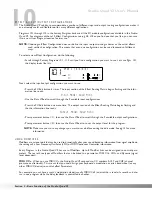
15
REVERBS
Reverberation is probably the most widely used effect because it allows you to simulate the sound reflection charac-
teristics of almost any kind of room. In a real room, reverb is a result of sound reflecting off room surfaces such as
the walls, floor, ceiling, and objects in the room. The materials, size, and shape of the room determine how long
these reflections echo and decay before dying out completely. These factors also help determine the audio charac-
teristics of the room, such as how long the high-frequency reverberations ring when compared to the low frequen-
cies, or how much initial "slapback" the room wall produces when a sound hits.
Today’s technology allows the Studio Quad V2 to offer a complete palette of flexibile, easy to use reverbs. There
are five basic reverbs to choose from.
1) Reverb - Simple, straight ahead reverb with only the most basic parameters.
2) Dual Reverb - Multi-dimensional reverb with flexible frequency band-splitting capabilities. The reverb can be divid-
ed into primary and secondary stages using selectable High or Low Pass crossovers.
3) Stereo Reverb - A true stereo version of the Reverb.
4) Stereo Dual Reverb - A true stereo version of the Dual Reverb
5) Gated Reverbs - A very linear, high energy reverb that can be set to decay, stay flat, or ramp up the reverb
decay, creating many unique ambient effects.
6) Room Echo - A true stereo, multi-tap delay for creating small ambient spaces. The delays are divided into four
sections of early reflections. These reflections can be placed anywhere in the stereo field and can be as dense or
sparse as necessary. The Room Delay also includes a feedback loop for delay regeneration.
Section 3 - Effects and Parameters
Studio Quad V2 User's Manual
















































